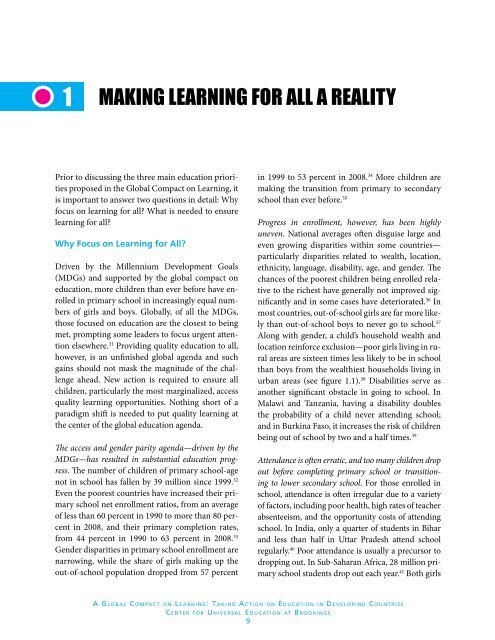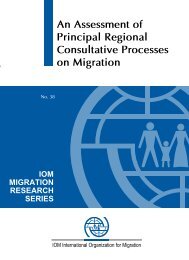A Global Compact on Learning - Brookings Institution
A Global Compact on Learning - Brookings Institution
A Global Compact on Learning - Brookings Institution
Create successful ePaper yourself
Turn your PDF publications into a flip-book with our unique Google optimized e-Paper software.
1<br />
MAKING LEARNING FOR ALL A REALITY<br />
Prior to discussing the three main educati<strong>on</strong> priorities<br />
proposed in the <str<strong>on</strong>g>Global</str<strong>on</strong>g> <str<strong>on</strong>g>Compact</str<strong>on</strong>g> <strong>on</strong> <strong>Learning</strong>, it<br />
is important to answer two questi<strong>on</strong>s in detail: Why<br />
focus <strong>on</strong> learning for all? What is needed to ensure<br />
learning for all?<br />
Why Focus <strong>on</strong> <strong>Learning</strong> for All?<br />
Driven by the Millennium Development Goals<br />
(MDGs) and supported by the global compact <strong>on</strong><br />
educati<strong>on</strong>, more children than ever before have enrolled<br />
in primary school in increasingly equal numbers<br />
of girls and boys. <str<strong>on</strong>g>Global</str<strong>on</strong>g>ly, of all the MDGs,<br />
those focused <strong>on</strong> educati<strong>on</strong> are the closest to being<br />
met, prompting some leaders to focus urgent attenti<strong>on</strong><br />
elsewhere. 31 Providing quality educati<strong>on</strong> to all,<br />
however, is an unfinished global agenda and such<br />
gains should not mask the magnitude of the challenge<br />
ahead. New acti<strong>on</strong> is required to ensure all<br />
children, particularly the most marginalized, access<br />
quality learning opportunities. Nothing short of a<br />
paradigm shift is needed to put quality learning at<br />
the center of the global educati<strong>on</strong> agenda.<br />
The access and gender parity agenda—driven by the<br />
MDGs—has resulted in substantial educati<strong>on</strong> progress.<br />
The number of children of primary school-age<br />
not in school has fallen by 39 milli<strong>on</strong> since 1999. 32<br />
Even the poorest countries have increased their primary<br />
school net enrollment ratios, from an average<br />
of less than 60 percent in 1990 to more than 80 percent<br />
in 2008, and their primary completi<strong>on</strong> rates,<br />
from 44 percent in 1990 to 63 percent in 2008. 33<br />
Gender disparities in primary school enrollment are<br />
narrowing, while the share of girls making up the<br />
out-of-school populati<strong>on</strong> dropped from 57 percent<br />
in 1999 to 53 percent in 2008. 34 More children are<br />
making the transiti<strong>on</strong> from primary to sec<strong>on</strong>dary<br />
school than ever before. 35<br />
Progress in enrollment, however, has been highly<br />
uneven. Nati<strong>on</strong>al averages often disguise large and<br />
even growing disparities within some countries—<br />
particularly disparities related to wealth, locati<strong>on</strong>,<br />
ethnicity, language, disability, age, and gender. The<br />
chances of the poorest children being enrolled relative<br />
to the richest have generally not improved significantly<br />
and in some cases have deteriorated. 36 In<br />
most countries, out-of-school girls are far more likely<br />
than out-of-school boys to never go to school. 37<br />
Al<strong>on</strong>g with gender, a child’s household wealth and<br />
locati<strong>on</strong> reinforce exclusi<strong>on</strong>—poor girls living in rural<br />
areas are sixteen times less likely to be in school<br />
than boys from the wealthiest households living in<br />
urban areas (see figure 1.1). 38 Disabilities serve as<br />
another significant obstacle in going to school. In<br />
Malawi and Tanzania, having a disability doubles<br />
the probability of a child never attending school;<br />
and in Burkina Faso, it increases the risk of children<br />
being out of school by two and a half times. 39<br />
Attendance is often erratic, and too many children drop<br />
out before completing primary school or transiti<strong>on</strong>ing<br />
to lower sec<strong>on</strong>dary school. For those enrolled in<br />
school, attendance is often irregular due to a variety<br />
of factors, including poor health, high rates of teacher<br />
absenteeism, and the opportunity costs of attending<br />
school. In India, <strong>on</strong>ly a quarter of students in Bihar<br />
and less than half in Uttar Pradesh attend school<br />
regularly. 40 Poor attendance is usually a precursor to<br />
dropping out. In Sub-Saharan Africa, 28 milli<strong>on</strong> primary<br />
school students drop out each year. 41 Both girls<br />
A <str<strong>on</strong>g>Global</str<strong>on</strong>g> Compa c t <strong>on</strong> <strong>Learning</strong>: Taking Acti<strong>on</strong> <strong>on</strong> Educat i o n in Developing Countries<br />
C e n t e r for Universal Educat i o n at <strong>Brookings</strong><br />
9






